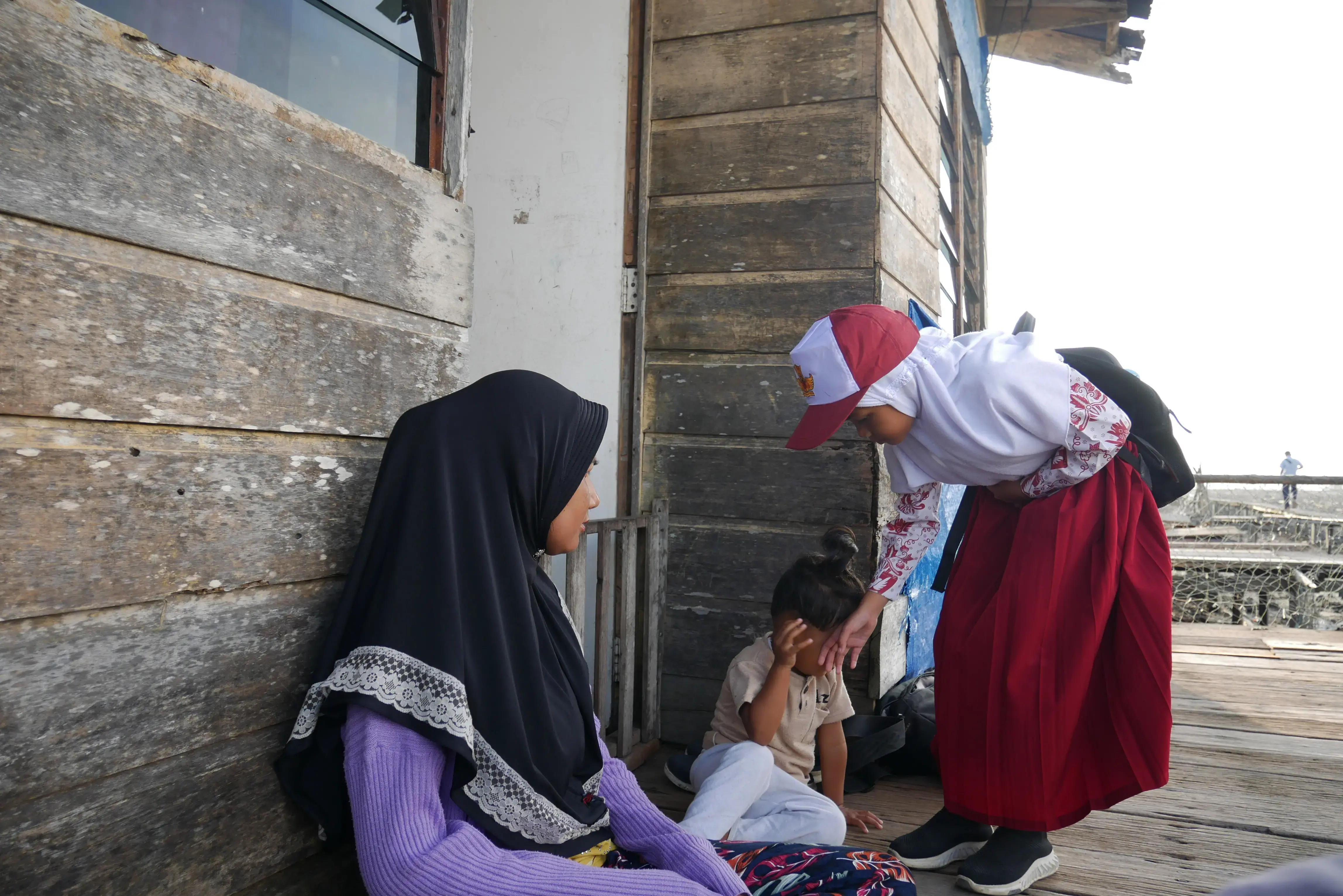
Mangrove deforestation in Indragiri Hilir, Riau, removes the villagers' final line of protection against the growing threat of large waves amid the climate crisis.
Lizawati was still in her first year of junior high school when a tidal wave hit her house at Kuala Selat village in Kateman district, Indragiri Hilir regency, Riau, one night in late 2006.
Lizawati and her family did not have much time other than to evacuate themselves from the house that stood in the coastal area of the village. The house and hundreds of others in Kuala Selat were swept away by the strong waves, forcing 800 villagers to look for new homes further from the sea.
Lizawati’s family eventually found a plot of land located several hundred meters from the seashore. But the trauma lingered, with anxiety haunting her every time high tide came and caused seawater to creep up inside the house.
“I can’t sleep at night,” said Lizawati, now a 30-year-old mother of two. “I’m afraid that the tidal wave will come again.”

As a nonprofit journalism organization, we depend on your support to fund journalism covering underreported issues around the world. Donate any amount today to become a Pulitzer Center Champion and receive exclusive benefits!
But the waves did come, forcing Lizawati and her family to move three times. They had to leave their home in 2011 and again in 2020 after another tidal wave hit the village.
“We’re always afraid that the waves will come again, and threaten our lives,” said Lizawati’s father Abdul Rahman.
Abdul and his family had lived in Kuala Selat since the 1960s because the village was a perfect place for a fisherman like him. Villagers could still catch shrimp and crabs living around the roots of the mangroves that grew on the village’s beach.
But their lives slowly changed as people, both villagers who used the wood to build houses, and businesspeople selling the logs, started cutting down the mangroves. The coastal erosion is getting worse, and villagers are feeling the encroaching threat from the sea.
A 1990 survey found around 112,568 hectares of mangroves spread across 15 districts in Indragiri Hilir, according to Riau-based Jikalahari environmental group. But the group found that by 2019 mangrove forests had decreased to 95,600 ha.
“The village’s defenses against the waves are increasingly being eroded,” Abdul said.

‘No more stronghold’
Samsuri, 52, one of elders of the Duano sea tribe, which was the first inhabitants of Kuala Selat, said the villagers faced fewer threats from the sea when the mangrove forests were still thick. The marine plant protected the village from high waves, while also becoming a haven for fish, making it a perfect place for fishing.
“When the mangrove collapsed, we lost our stronghold. Our houses are prone from these threats from the sea,” said Samsuri, who had moved twice as he lost his land from the coastal erosion.
Mangrove logging in the village started to intensify in the late 1980s when people from outside the village cut down mangroves and sold the wood.
Many villagers have cut down mangroves, and Samsuri said they had no other choice as they needed to build houses and paths for walking and vehicles on the coast. Most of the residents worked as fishermen, with insufficient income to buy essentials like wood.
“Even though the government was mad at us, we can’t get wood because the economic situation was difficult,” Samsuri said. “It’s impossible to buy. We had no money.”

The coastal indigenous community has been using mangroves as a source of life for decades, but they only cut down the mangroves when they need it, said Zainal Arifin Hussein, director of the Bangun Desa Payung Negeri (BPDN) environmental group that focuses on issues pertaining to mangroves and coastal communities in Indragiri Hilir.
Zainal blamed the lack of supervision from local authorities for the ongoing mangrove logging that is done by people from outside the village. “The coastal community is aware of the impacts of mangrove deforestation. Now they are starting to prohibit loggers from outside,” he continued.
The mangrove deforestation in Kuala Selat occurred at this unfortunate time of climate crisis, in which the sea surface temperature has risen to reach a new global record this year.
The hotter sea surface temperature leads to a greater pressure difference, making sea-level wind stronger. “The stronger and longer the wind blows, the greater the energy transferred from the air to the water surface, resulting in high sea waves,” said ocean researcher Ardian Rizal at the University of Southern Mississippi in the United States.
But high waves can also occur without strong wind in the area. This kind of wave, scientifically known as a “swell wave”, is triggered by the wind blowing in other places. The wave later builds energy and hits the coast some distance away.
For high waves that regularly hit Kuala Selat and other parts of the Riau eastern coast, swells likely come from the South China Sea and surrounding ocean, as suggested by Ardian’s study published in 2020.
The climate crisis has also caused a rise in extreme weather events such as storms, which can also trigger tidal waves when they occur in coastal areas.
Lost homes
When the villagers lost their mangroves, the tidal waves repeatedly eroded the coastal land of Kuala Selat over the years. For some people, that means the beach is getting closer to their home. When the tidal wave hit in 2006, the high tide and strong waves swept houses and docked ships and dragged them into the sea, including Samsuri’s house. “Our house sank with the sea,” he said.
Villagers moved further inland after the 2006 incident. But the sea crept up to them as the erosion continued, pushing them further from the beach. According to Samsuri, some villagers had moved nearly one kilometer from the beach in the past few years.
A series of satellite images from Google Earth showed that the seawater eroded more than 400 meters of land between 2008 and 2022 from the initial shoreline observed a few decades ago. One image showed that a house stood on the edge of the sea in the early years of the observation and was gone by 2022.

Kuala Selat is the worst-hit area of eight coastal villages in Kateman district. While some of the 800 villagers have moved further inland, more than half still live on the seashore despite the threat of being hit by the tidal waves at any time.
These people, Samsuri included, are now worried that they will lose their homes if tidal waves come. “If this village is destroyed,” Samsuri said, “where will we live?”











